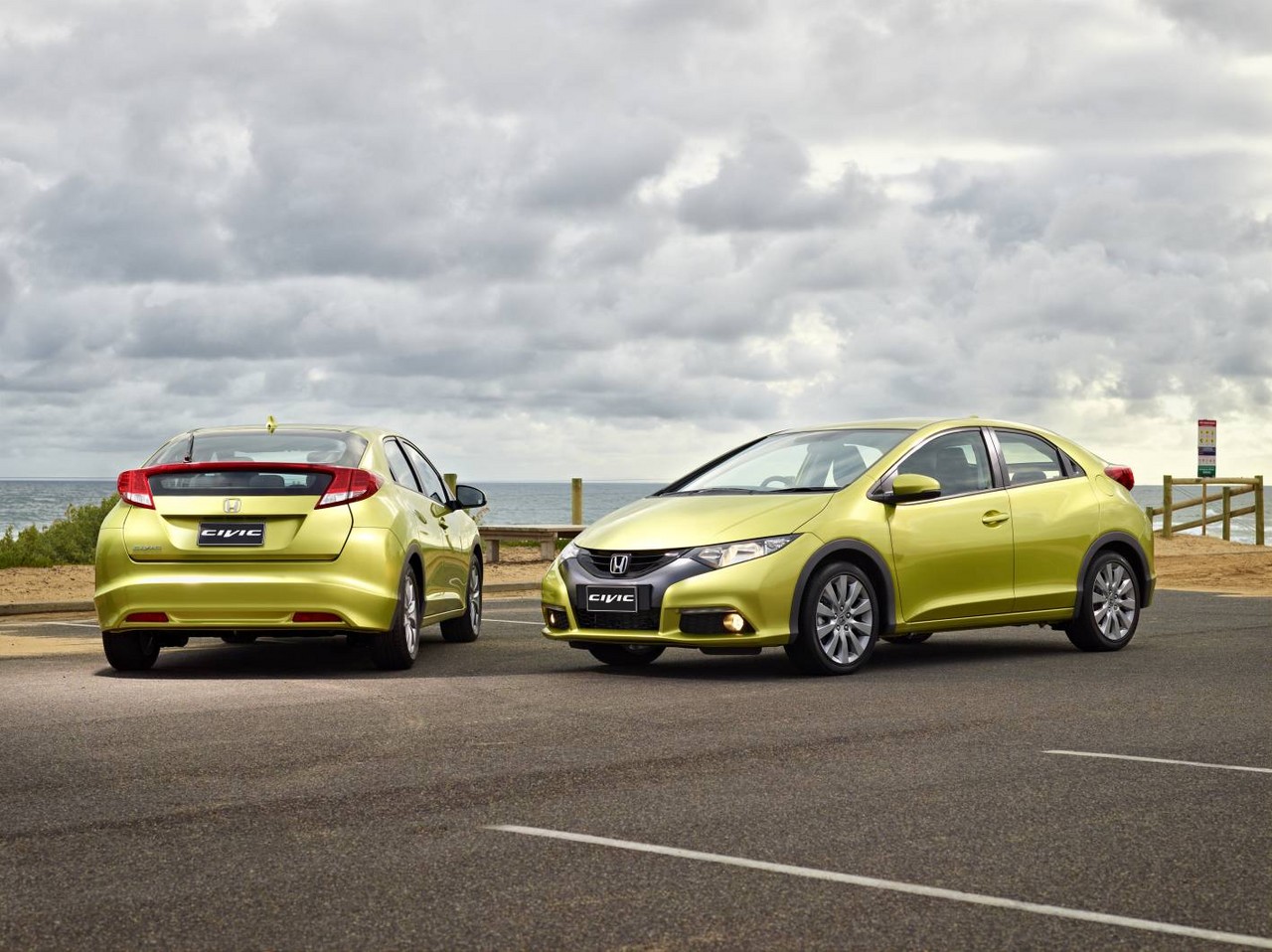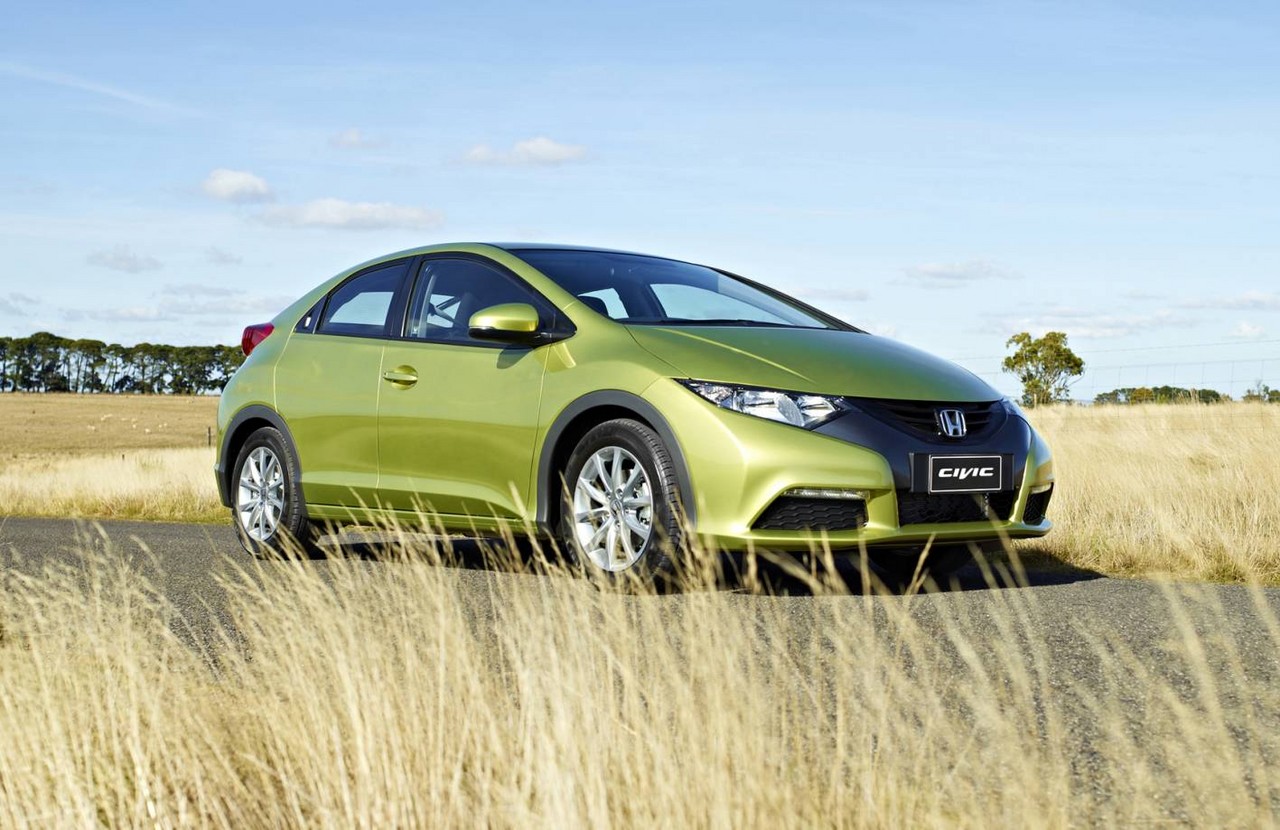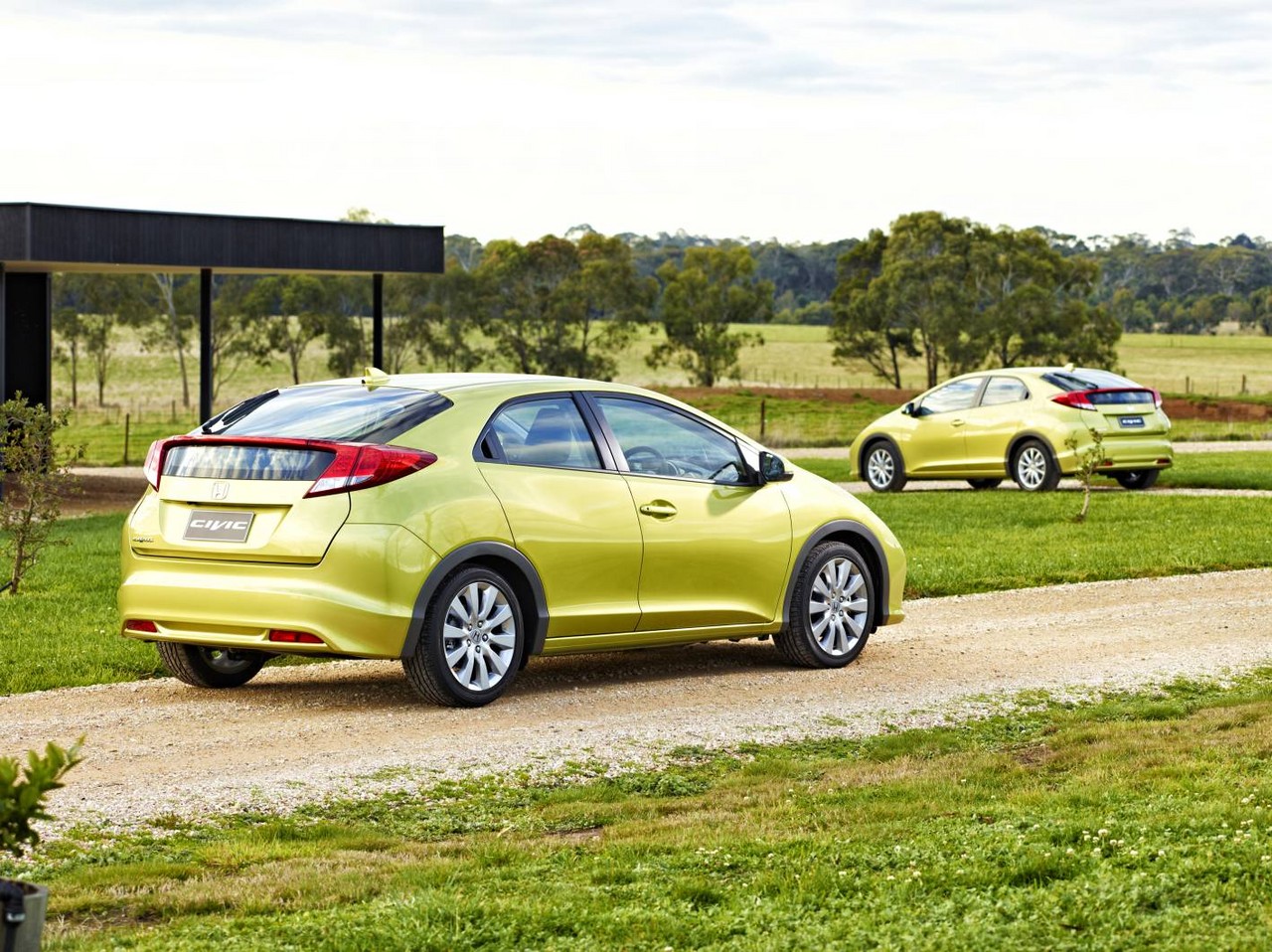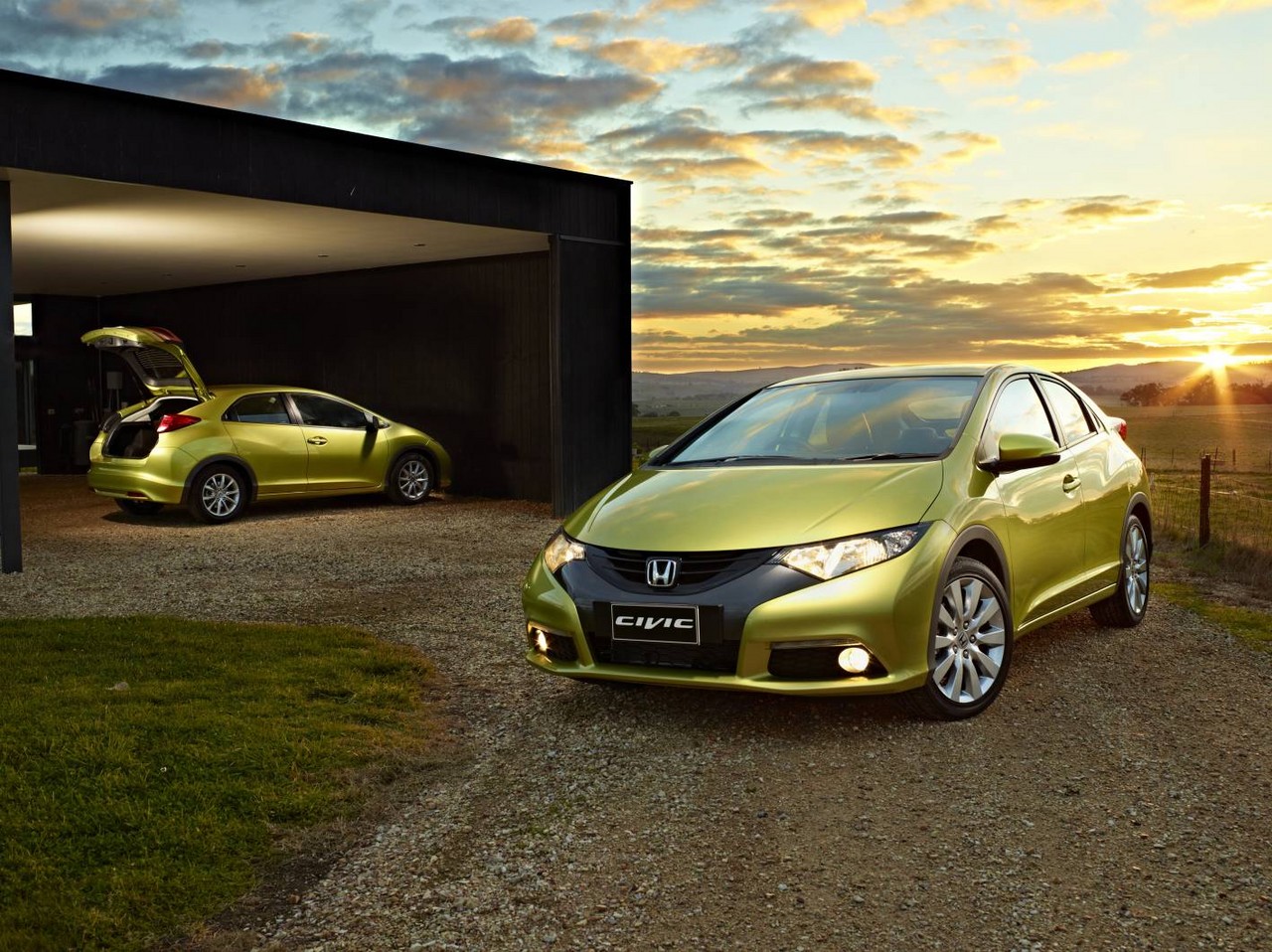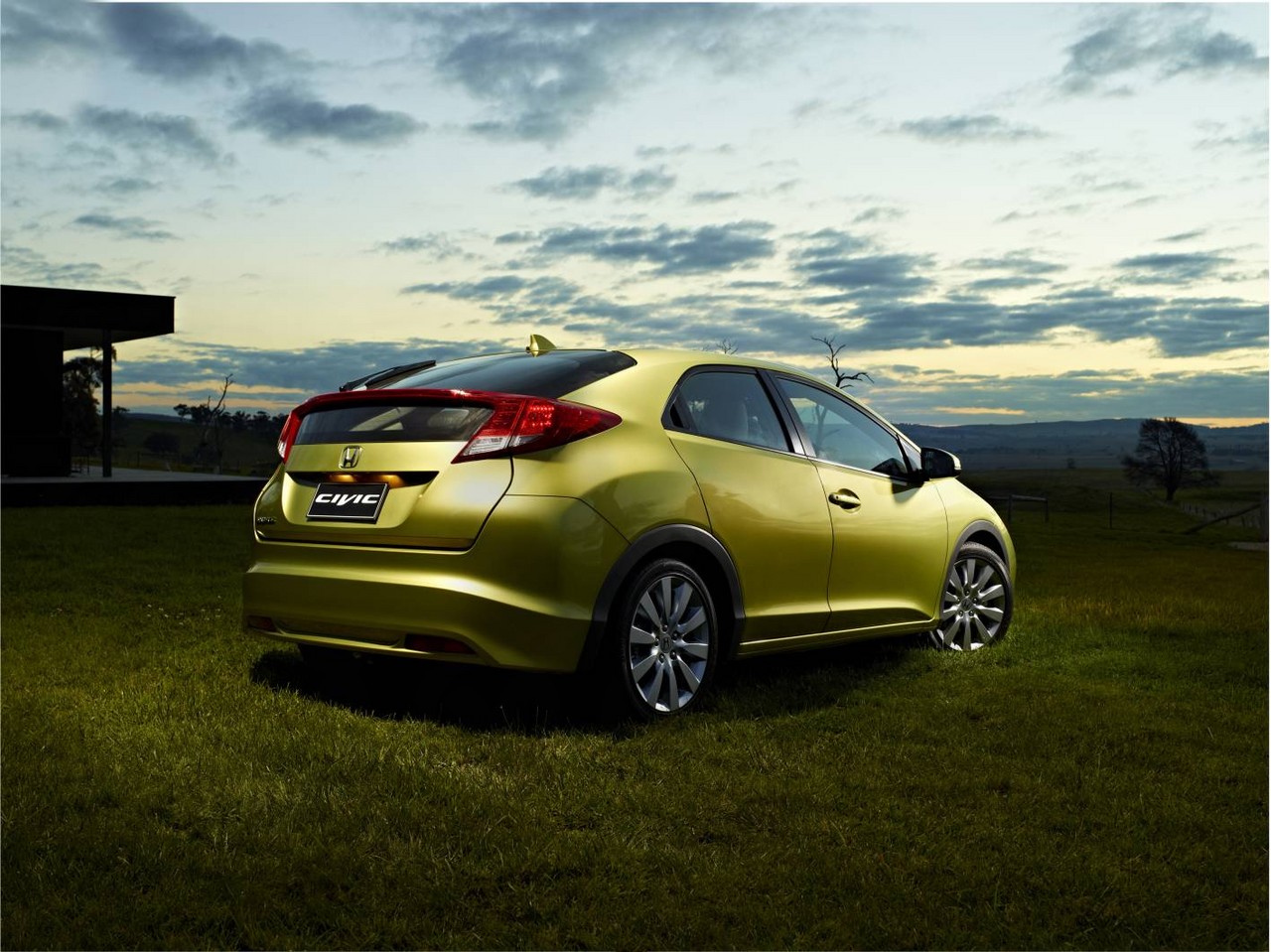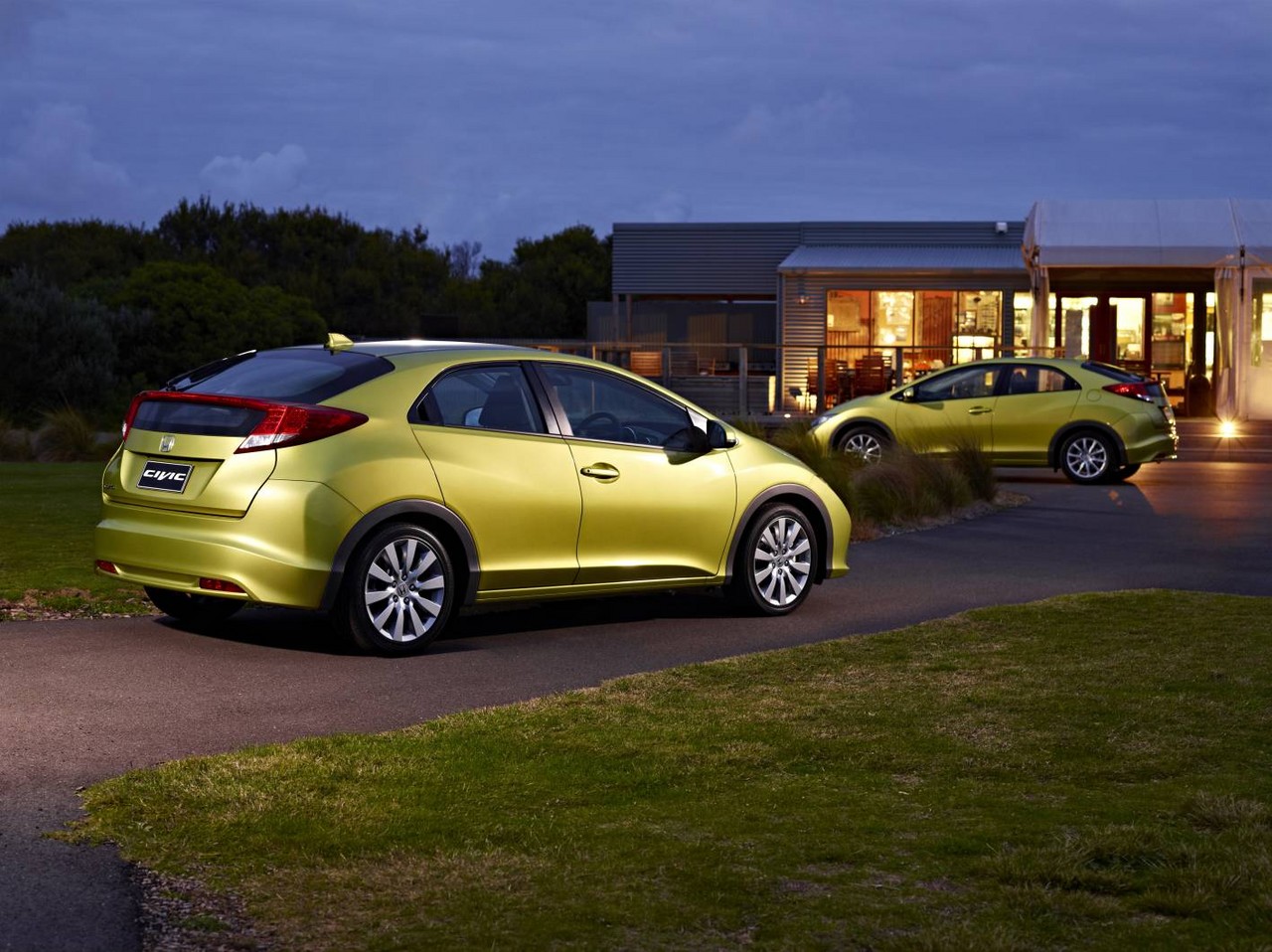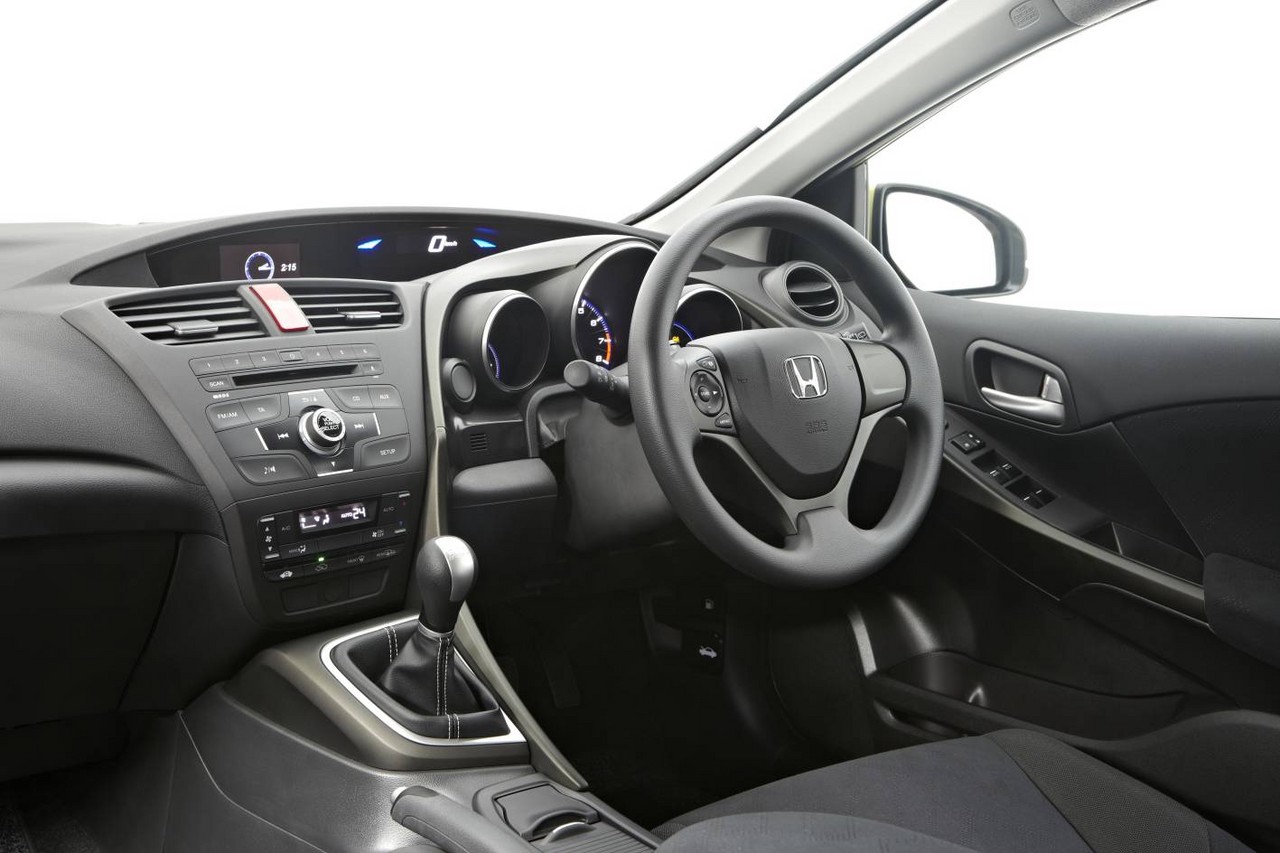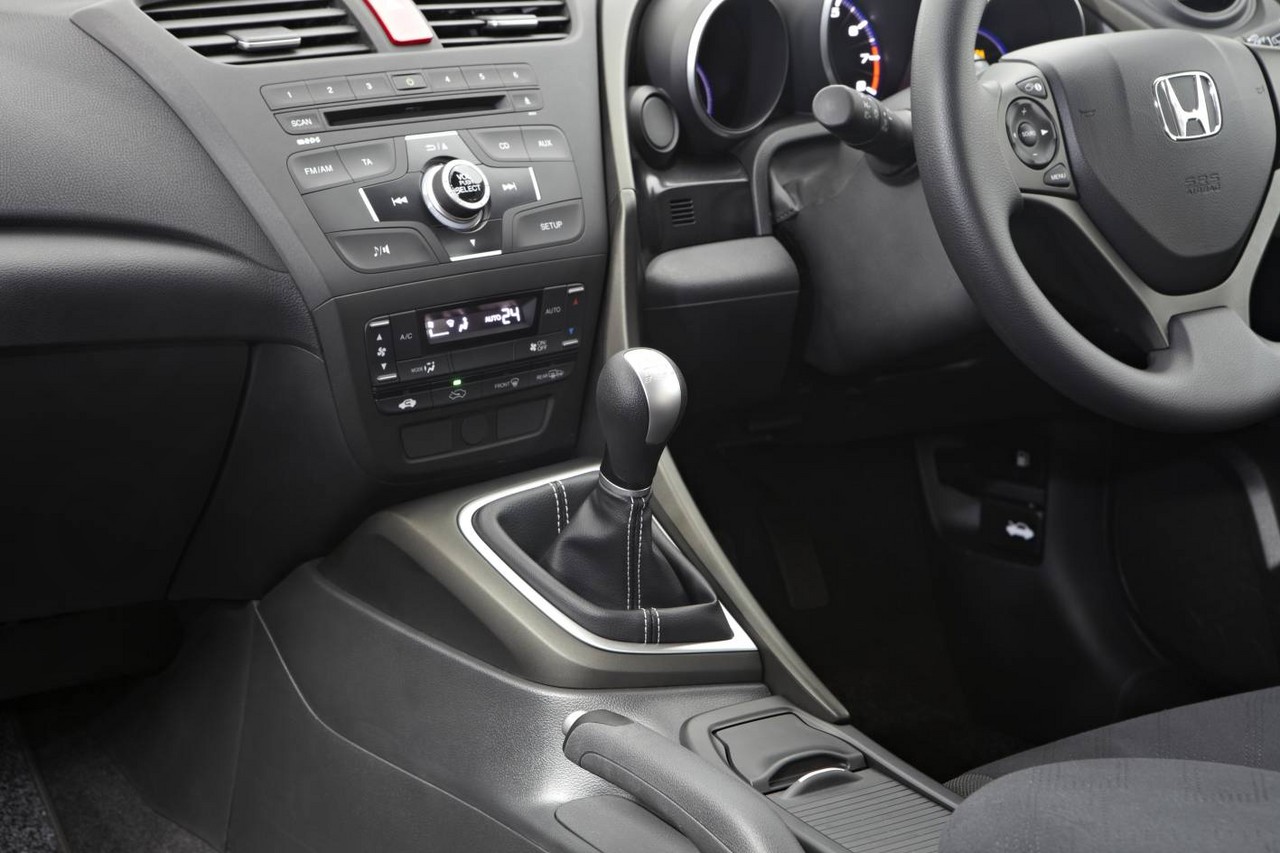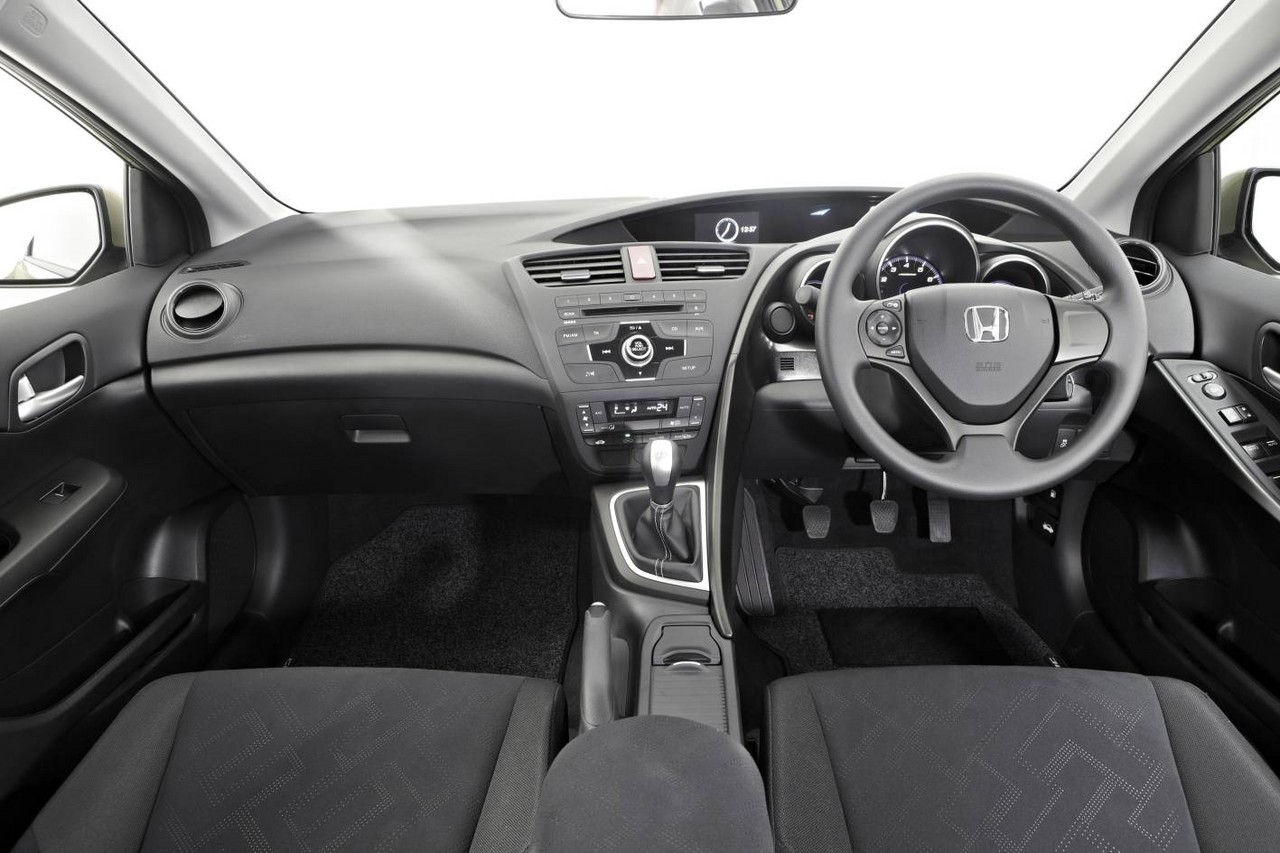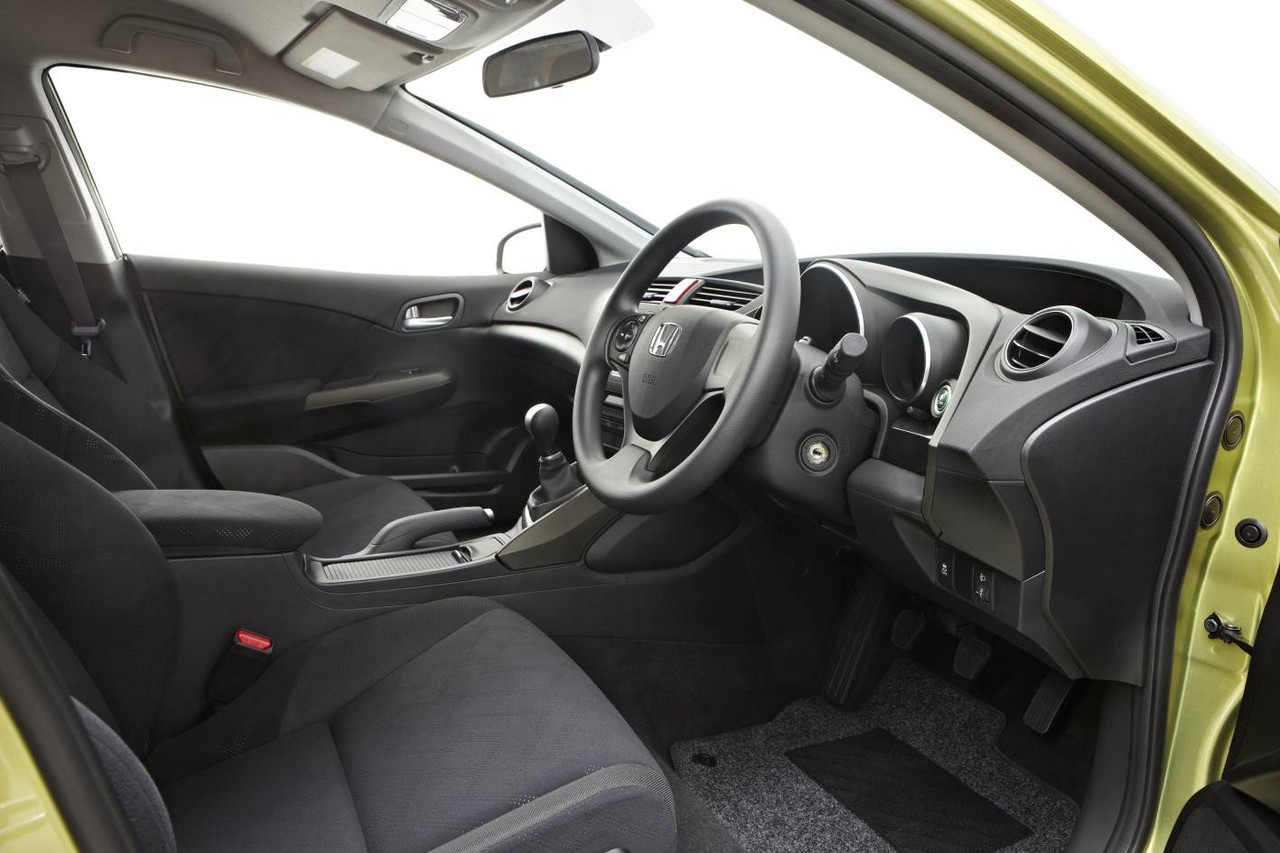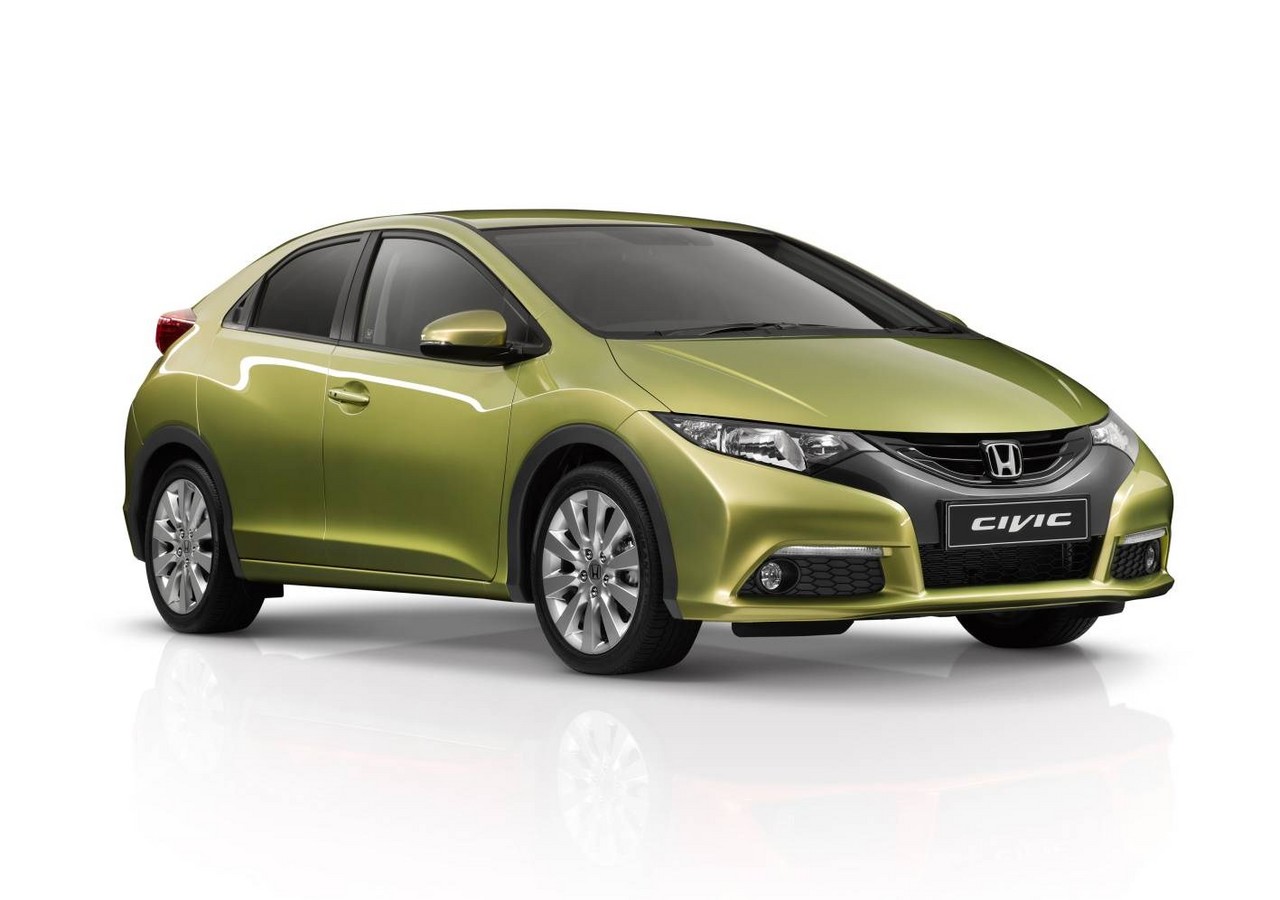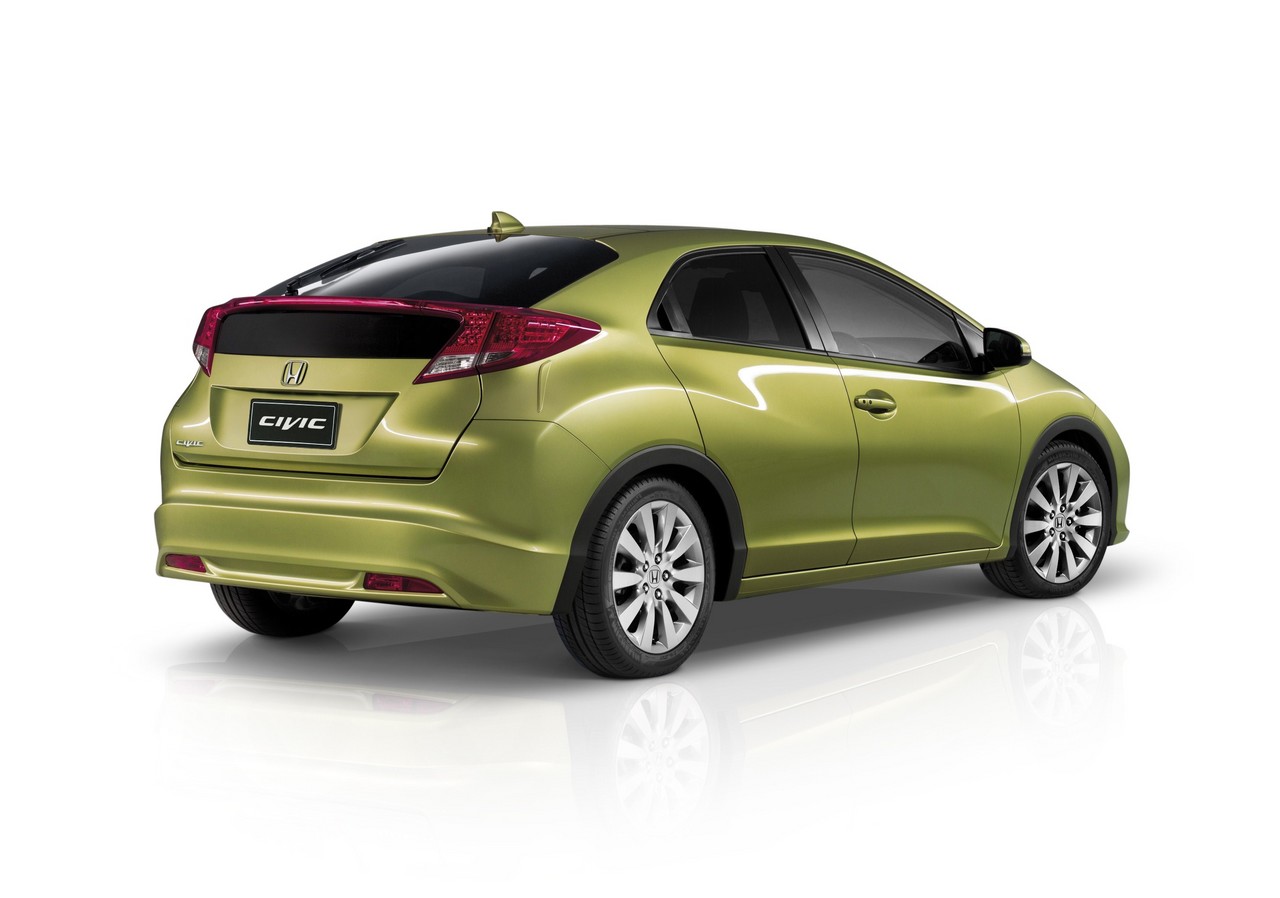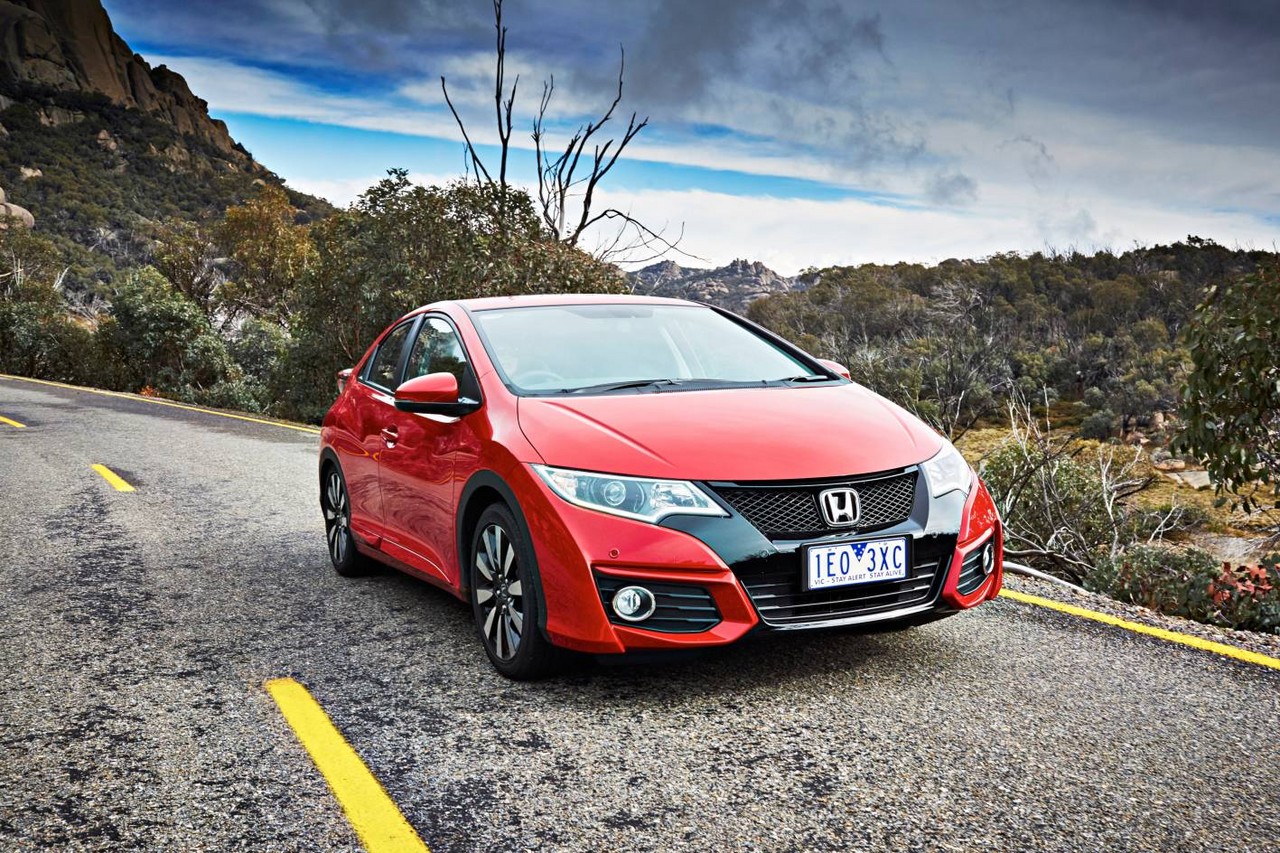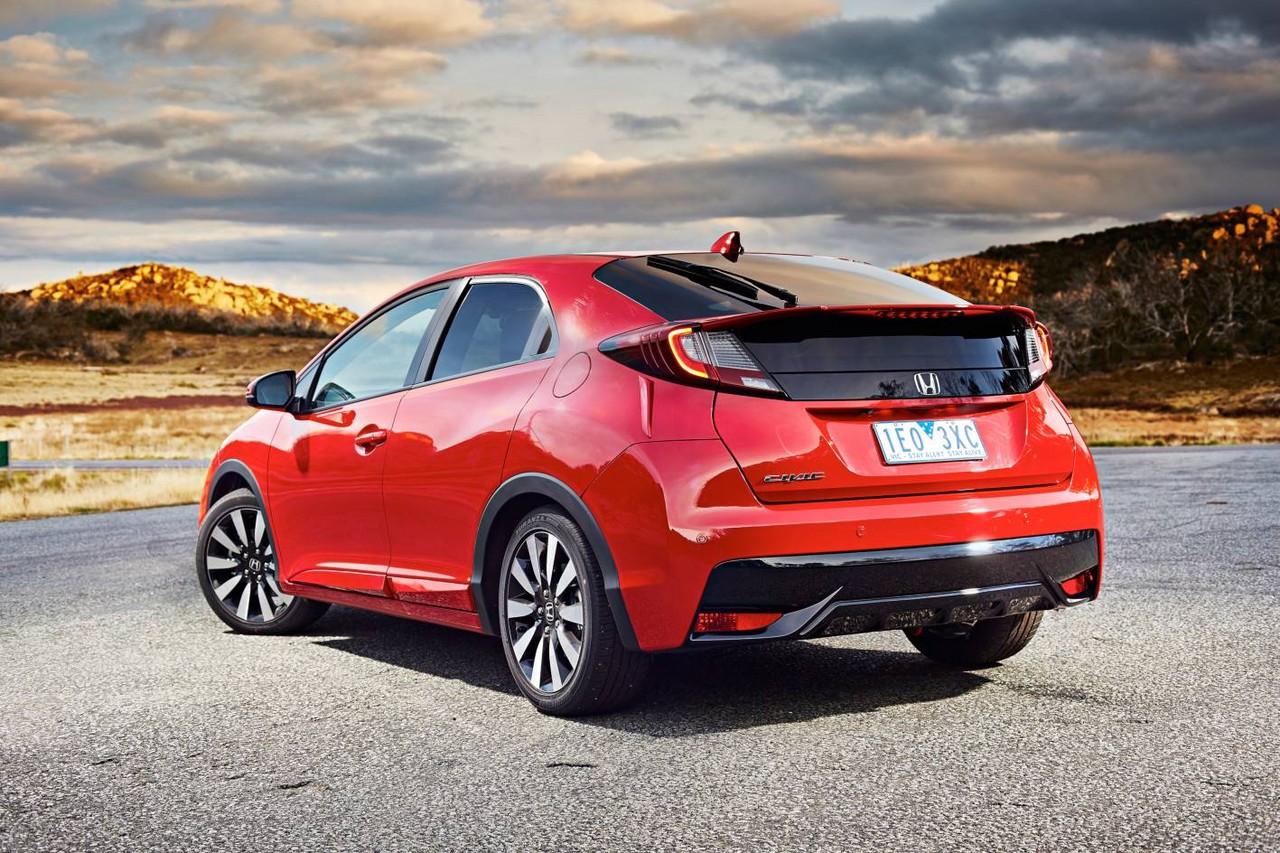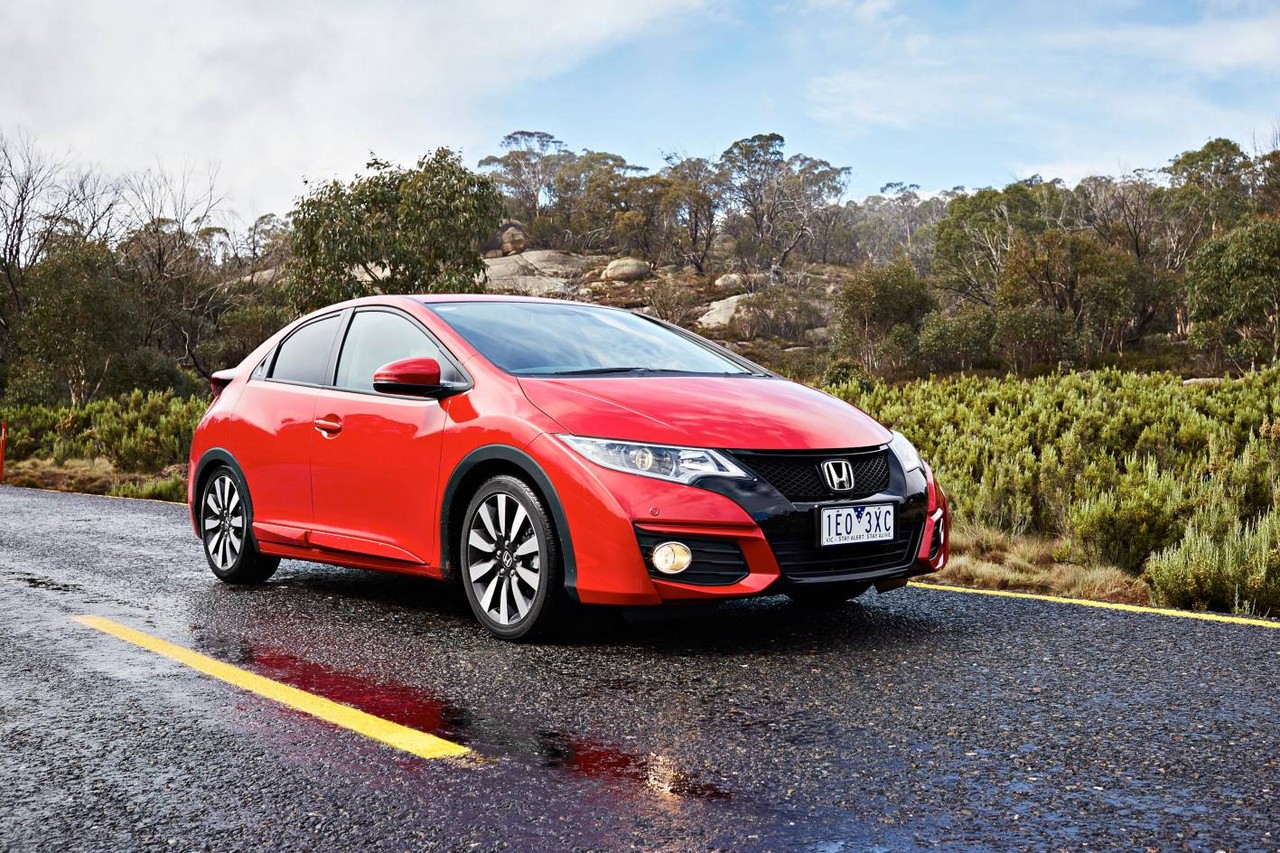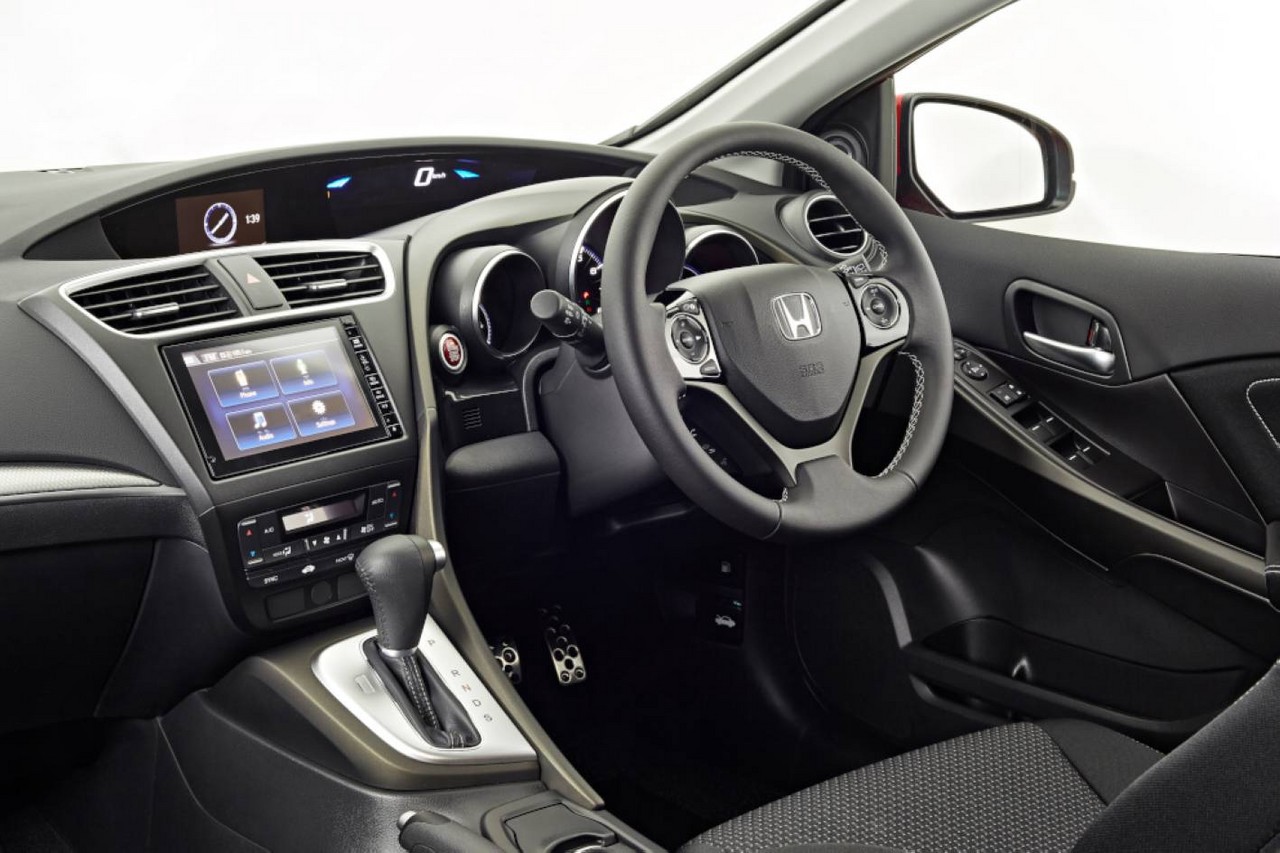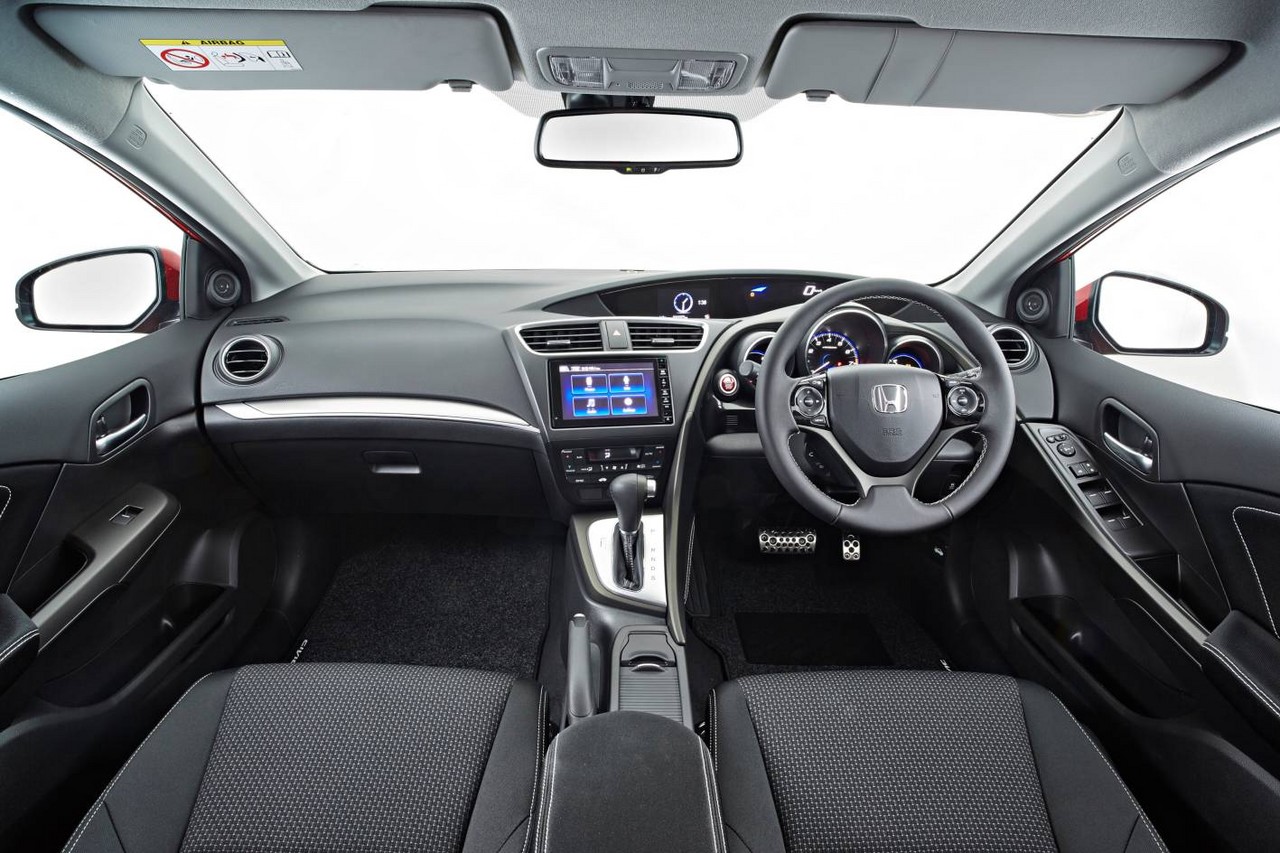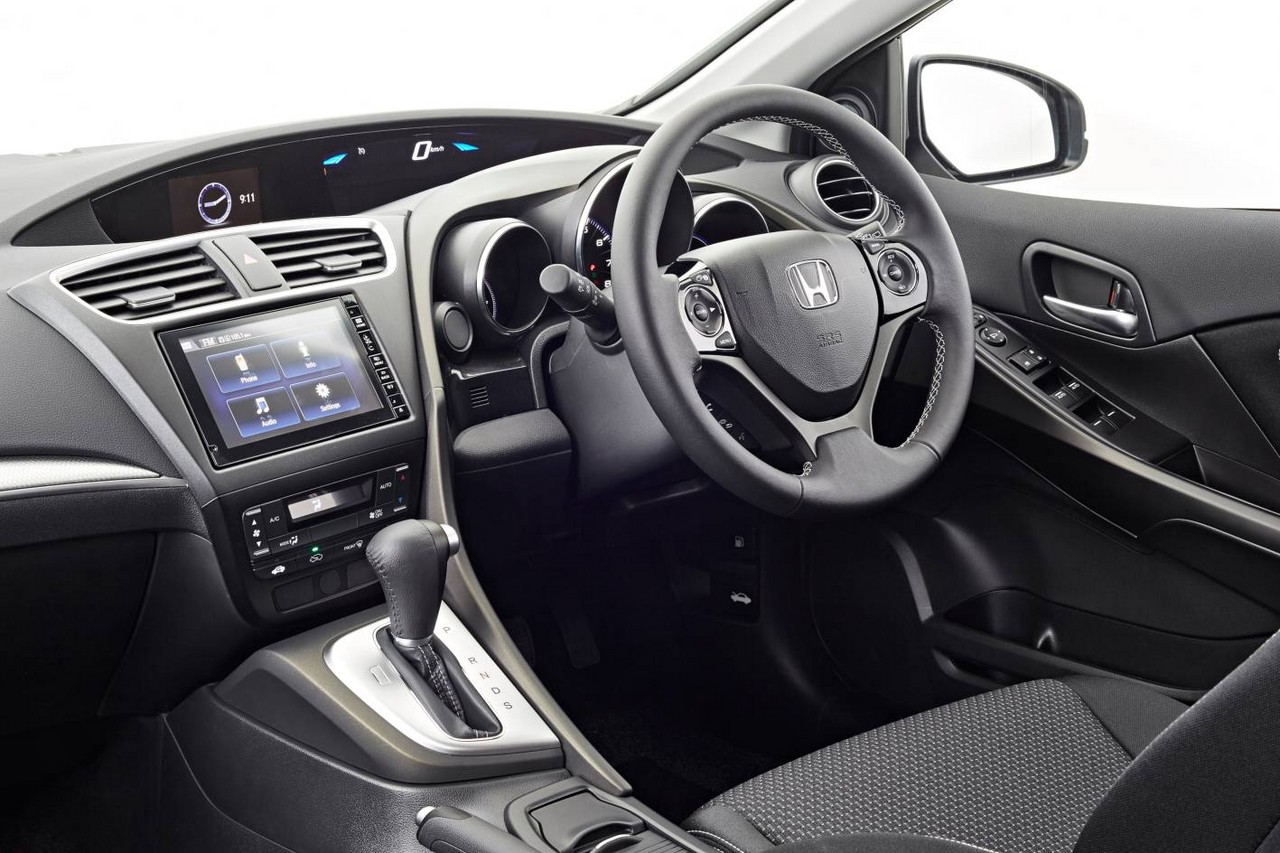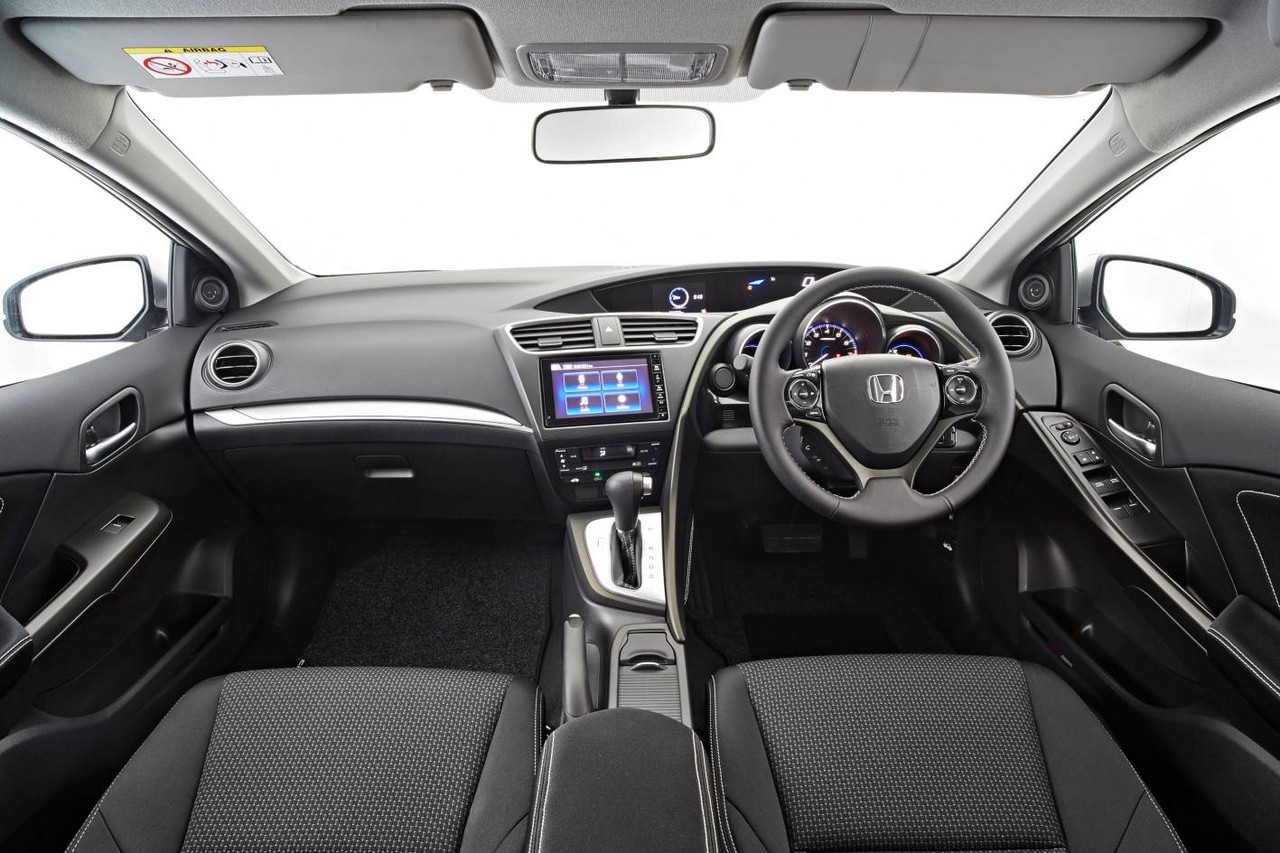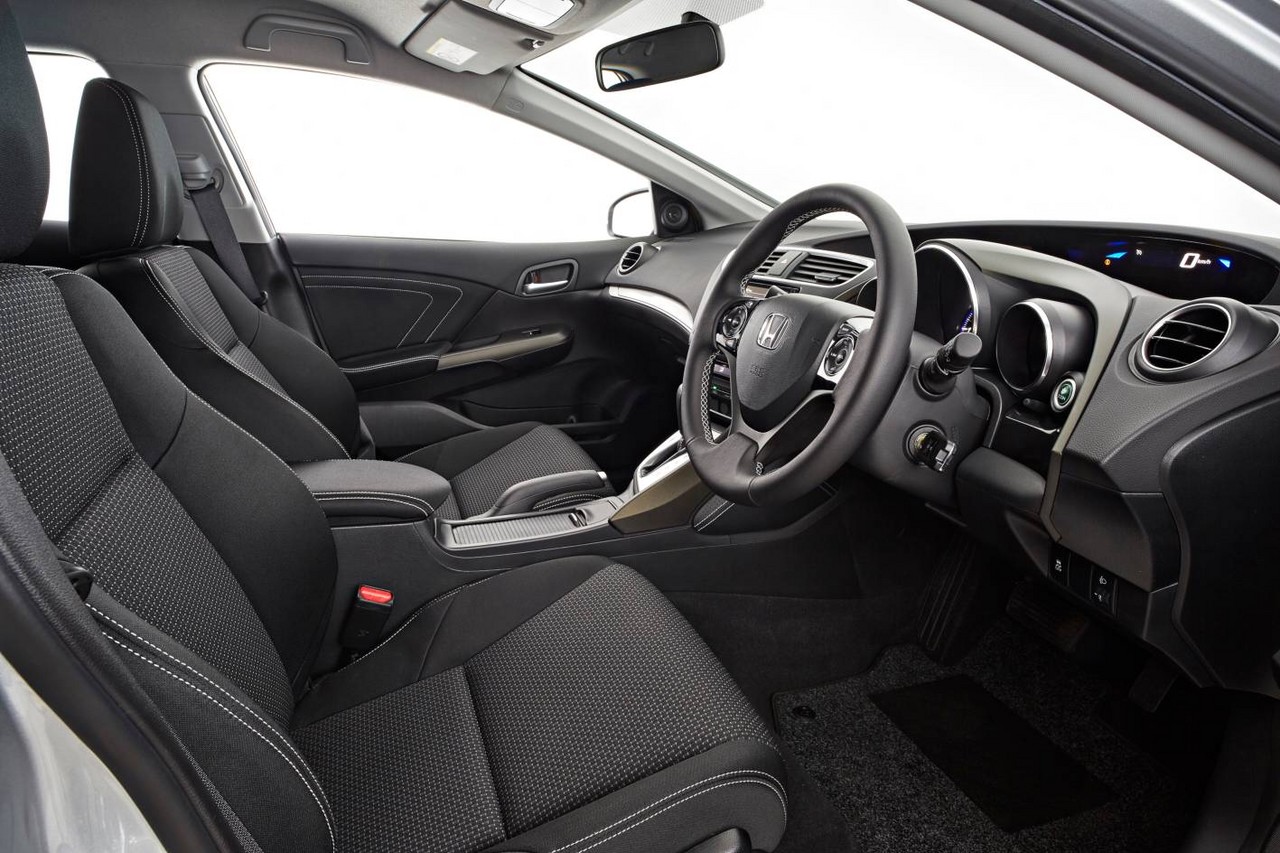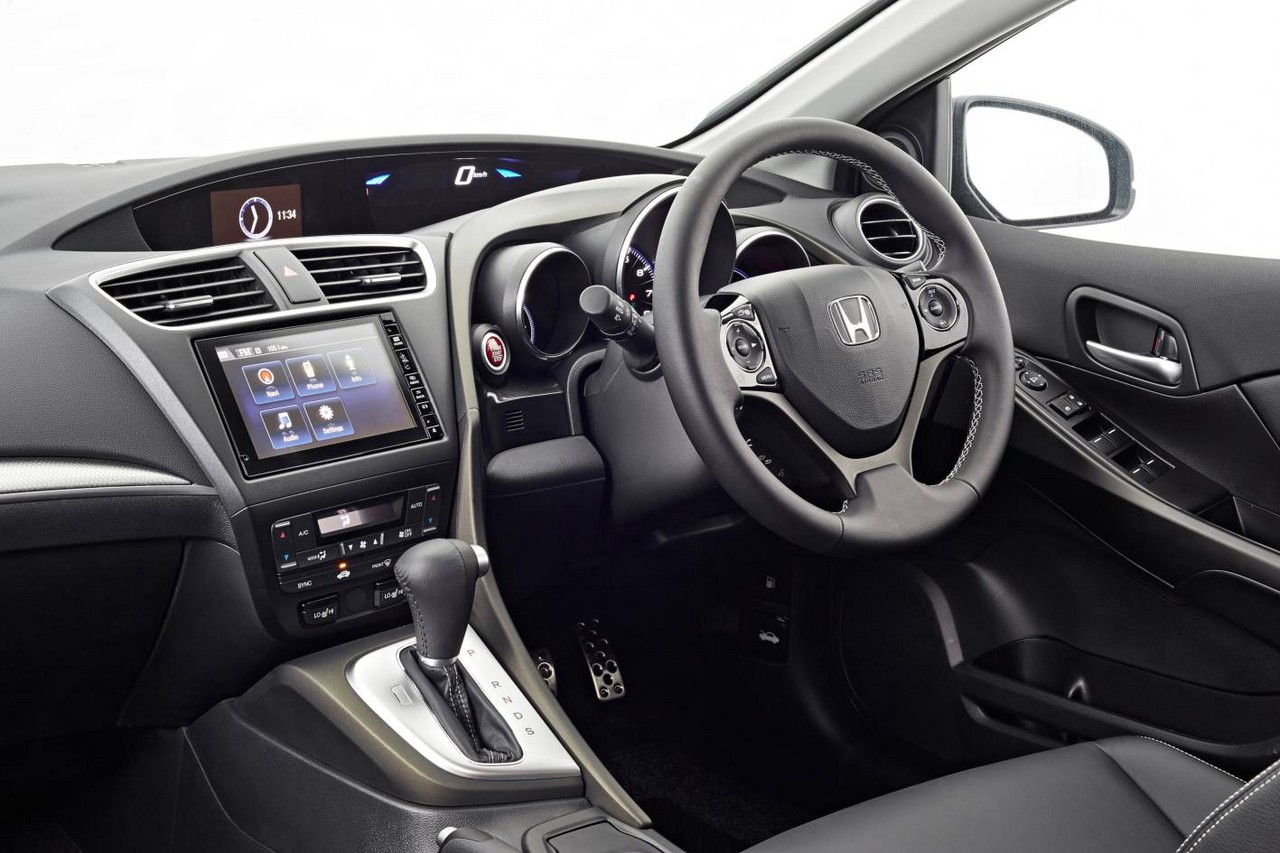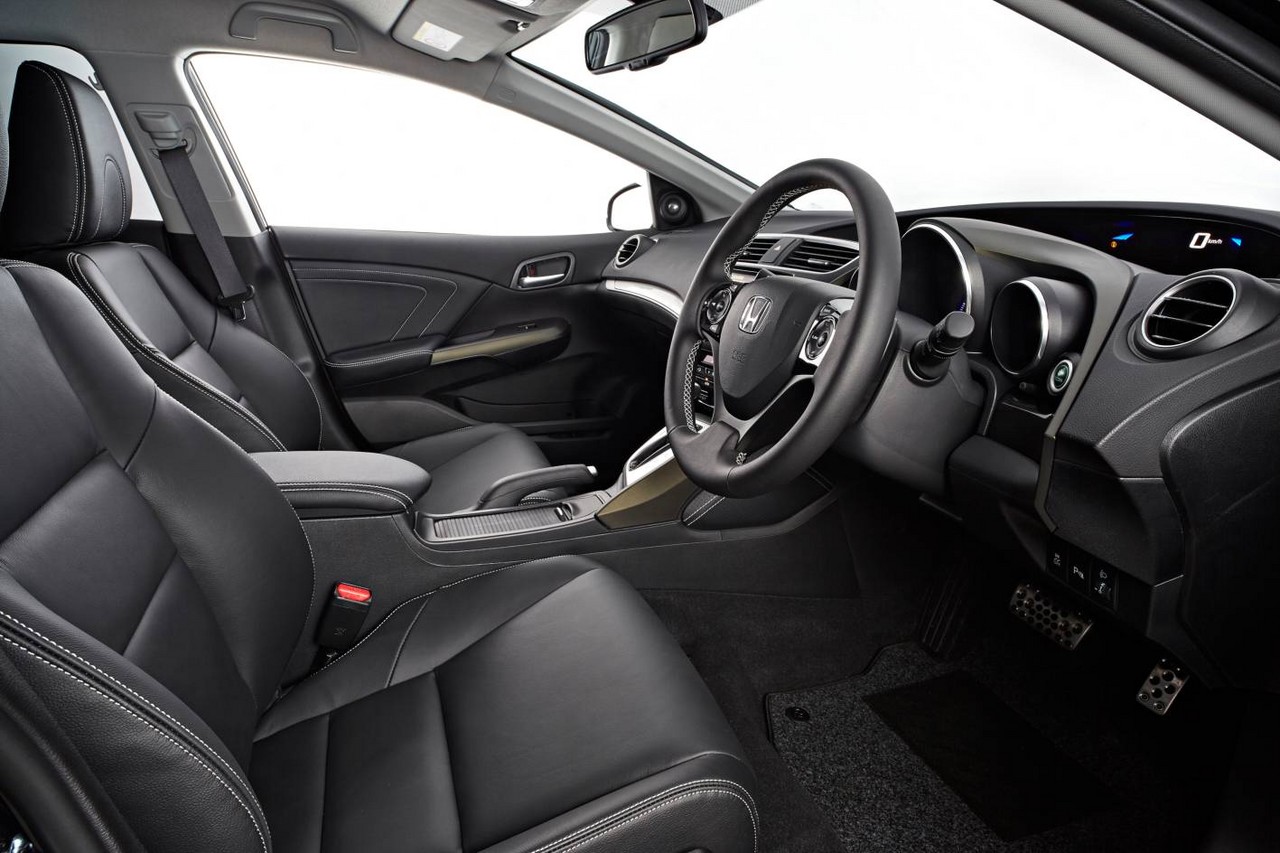
- Folding ‘magic seats’ provide immense cargo space
- Frugal and quiet turbo-diesel engine
- Refined manual transmission
- Comfortable ride
- Well-insulated cabin
- High standard of fit and finish
- Outdated five-speed automatic transmission
- High driving position and poor rear visibility
- Vague steering
- Road noise on coarse surfaces
- Outclassed by Volkswagen Mk.7 Golf and Mazda BM Mazda3
Honda FK2.I and FK3.I Civic Hatch (2012-14)
Overview
Released in Australia in June 2012, the ninth generation Honda Civic hatchback was manufactured in Swindon, UK. The front-wheel drive Civic hatchback range initially consisted of VTi-S and VTi-L variants which were powered by 1.8-litre four-cylinder petrol engines, followed by the VTi-LN in January 2013. In April 2013, Civic hatchback range was further expanded with DTi-S variants which were powered by 1.6-litre turbo-diesel engines.
Engines
For the FK2 Civic, the 1.8-litre R18A1 four-cylinder petrol engine had an aluminium-alloy block and cylinder head, a single overhead camshaft (chain-driven), four valves per cylinder, a variable length intake manifold, drive-by-wire throttle control and a compression ratio of 10.6:1. The engine also featured Honda’s i-VTEC (Intelligent Variable Valve Timing and Lift Electronic Control) system which used two distinct camshaft profiles to vary intake valve timing and lift for low RPM (1500-3500 rpm) and high RPM (5200-7000 rpm) operations; and,
For the FK3 Civic (i.e. the DTi-S variant), the 1.6-litre diesel engine had an aluminium block and cylinder head, double overhead camshafts, common-rail direct injection (operating at 1800 bar), a variable geometry Garrett turbocharger providing maximum boost pressure of 1.5 bar (21.75 psi), four valves per cylinder, exhaust gas recirculation and a compression ratio of 16.0:1. The engine also featured an ‘Auto Stop’ function which enabled it to shut down when the vehicle was stationary.
While the petrol engine was available with six-speed manual and five-speed automatic transmissions, the diesel engine was solely available with the former.
| Variant | Engine | Trans. | Years | Peak power | Peak torque |
|---|---|---|---|---|---|
| VTi-S | 1.8-litre petrol I4 | 6sp man., 5sp auto |
2012-14 | 104 kW at 6500 rpm | 174 Nm at 4300 rpm |
| VTi-L | 1.8-litre petrol I4 | 5sp auto | 2012-14 | 104 kW at 6500 rpm | 174 Nm at 4300 rpm |
| VTi-LN | 1.8-litre petrol I4 | 5sp auto | 2013-14 | 104 kW at 6500 rpm | 174 Nm at 4300 rpm |
| DTi-S | 1.6-litre turbo-diesel I4 | 6sp man. | 2013-14 | 88 kW at 4000 rpm | 300 Nm at 2000 rpm |
Dimensions
Compared to the FK2/FK3 Civic sedan , the FK2/FK3 Civic hatchback was 210 mm shorter (at 4330 mm), 15 mm wider (1770 mm), 40 mm taller (1475 mm) and had a 65 mm shorter wheelbase (2605 mm).
Steering and suspension
The FK2/FK3 Civic hatchback had electric power-assisted steering, MacPherson strut front suspension and a torsion beam rear axle.
Safety equipment
Standard safety equipment for the FK2/FK3 Civic included dual front airbags, front side airbags, full-length curtain airbags, ABS, electronic brake force distribution, brake assist, electronic stability control, traction control and front seatbelts with pretensioners and load limiters.
Euro NCAP and ANCAP crash testing
In Euro NCAP testing , the FK2/FK3 Civic hatchback received a five star safety rating, including a 94 per cent adult occupant protection rating and an 83 per cent child occupant protection rating. In the offset crash test, there was a slight risk of serious chest and leg injury for the driver. Maximum points were awarded in the side impact test and, in the more severe pole test, there was a slight risk of serious chest and abdominal injury. Under ANCAP’s methodology , this testing resulted in a score of 36.03 out of 37.
Features: Civic VTi-S, DTi-S, VTi-L and VTi-LN
Standard features for the Civic VTi-S hatchback initially included 16-inch alloy wheels, a four speaker sound system with MP3/WMA-compatibility, auxiliary inputs (USB/iPod), climate control air conditioning, automatic headlights, 60/40 split and folding rear seats, a multi-function steering wheel, remote central locking, power windows and heated mirrors, a height and reach adjustable steering wheel, height adjustable driver’s seat, 12 volt power outlet and an immobiliser. In January 2013, however, standard features were extended to include a six speaker sound system, Bluetooth connectivity, cruise control and a reversing camera.
Compared to the VTi-S, the Civic DTi-S was further equipped with 17-inch alloy wheels and rain-sensing wipers. Unique within the range, the DTi-S was also fitted with an Active Noise Cancellation (ANC) system emitted reverse phase audio signals via the sound system override unwanted frequencies. ANC was first introduced by Honda on the KB1 Legend in 2006.
Relative to the DTi-S, the Civic VTi-L hatchback added climate control air conditioning, leather seat trim, heated front seats, a reversing camera, a leather-wrapped steering wheel and power folding mirrors. From January 2013, the VTi-L hatchback was fitted with cloth seat trim (previously leather) which did not have a heating function, but gained power adjustable front seats, a proximity key, push-button start and rear privacy glass.
The range-topping Civic VTi-LN hatchback was distinguished by its satellite navigation system (including live traffic updates), DVD player, leather seat trim and heated front seats.
April 2014: Civic hatchback update
In April 2014, the Civic hatchback underwent a minor update with cosmetic changes and revised suspension. Visually, the post-April 2014 Civic hatchbacks could be identified by its piano-black finish for the front bumper, black treatment for the lower section of the rear bumper, piano-black finish for the tailgate and new 17-inch alloy wheel designs (where fitted).
Standard features were extended to include rear privacy glass, while interior changes included white stitching for the front seats, steering wheel, knee pad and centre armrest, brighter trim surrounding the switches and air vents, and a piano black treatment for the steering wheel.
Related links
- Brochure: Honda FK2/FK3 Civic Hatch (April 2013)
- Specifications: Honda FK2/FK3 Civic Hatch (2013)
- Honda News: All-New Honda Civic Hatch Lands in Australia (June 2012)
- Honda News: The Feature-Packed 13YM Honda Civic Hatch Has Arrived (January 2013)
- Honda News: Honda’s First Diesel Arriving Down Under (February 2013)
- Honda’s European-Styled Civic Hatch Gets Makeover (April 2014)
Review: Honda FK2.II Civic Hatch (2015-16)
Overview
Released in Australia in April 2015, the FK2 Series II (FK2.II) Civic Hatch could be identified by its new front mask including headlights with integrated daytime running lights, new bumpers, side skirts, rear spoiler and LED tail-lights. Inside, there were new seat fabrics and stitching, new door trims with chrome door handles and a black metallic control panel.
The FK2.II Civic Hatch introduced Honda’s ‘Agile Handling Assist System’ (AHAS). AHAS operated in conjunction with the electronic stability control system to apply light braking pressure to the inside wheels when cornering to generate yaw and reduce understeer.
| Engine | Variant | Trans. | Peak power | Peak torque |
|---|---|---|---|---|
| 1.8-litre petrol I4 | VTi-S | 6sp man., 5sp auto |
104 kW at 6500 rpm | 174 Nm at 4300 rpm |
| VTi-L, VTi-LN |
5sp auto |
Features
Standard features for the Mk.9-II Civic Hatch included Honda’s ‘Display Audio’ system which included Bluetooth mobile connectivity, audio streaming, mirroring functionality (compatible iPhone only) and rear camera display.
Standard features for the Civic VTi-L and VTi-LN were extended to include front and rear parking sensors.
Related links
